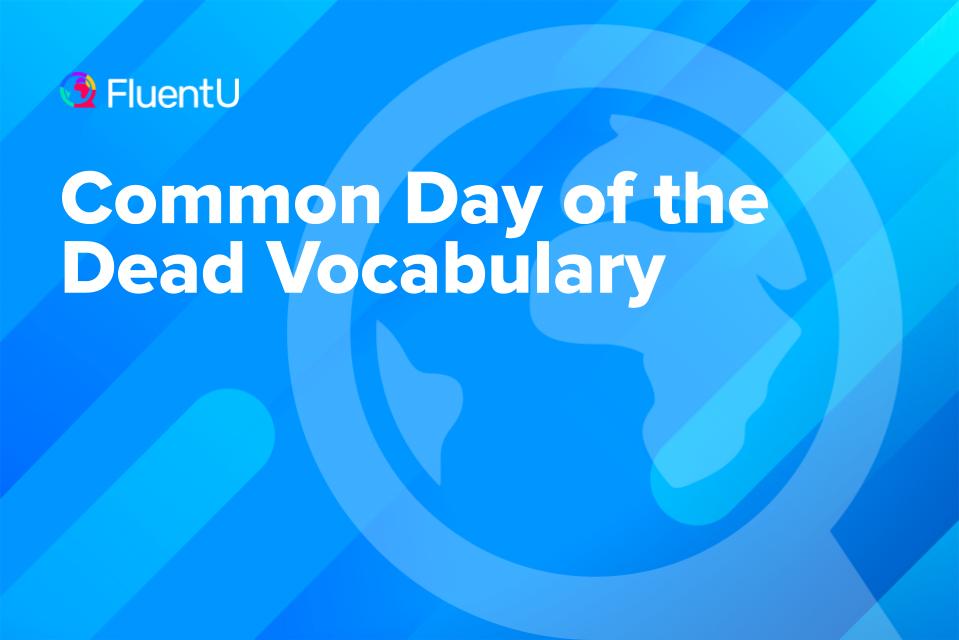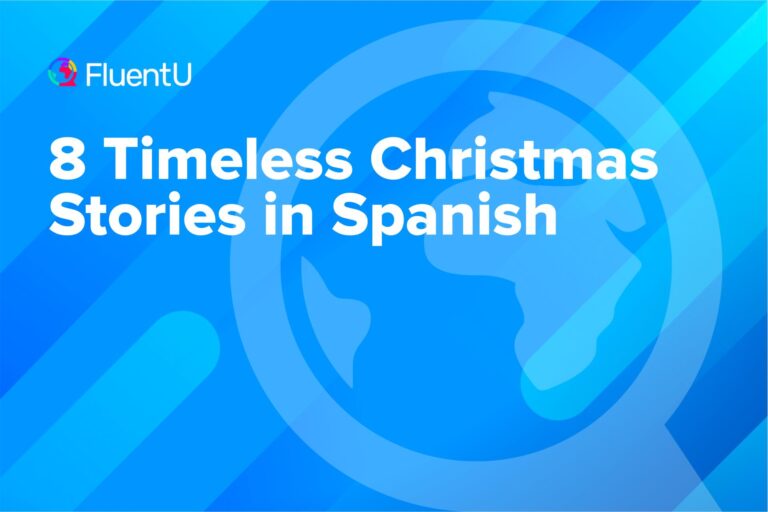Common Day of the Dead Vocabulary

You may know it as one of Latin America’s (particularly Mexico’s) most important holidays, but the Day of the Dead is actually celebrated around the world.
But what exactly is this holiday, and what’s its relation to Halloween? Does it involve trick-or-treating and telling scary stories? Or is it just going to visit some old graves?
Download: This blog post is available as a convenient and portable PDF that you can take anywhere. Click here to get a copy. (Download)
Most Common Vocabulary for The Day of the Dead
The name for the day varies across countries. In Bolivia, the day is called the Día de las Ñatitas (Day of the Skulls), whereas in Brazil it’s Finados (the Day of the Dead, in Portuguese).
The day is also sometimes referred to across the world as the Día de Todos los Santos (Day of the Saints) or simply Todos Santos (All Saints). The night of November 1 can also be called La Noche de Duelo (the Night of Pain/Sorrow).
Other important related words are:
- La muerte (death)
- La tumba (the tomb)
- Calaveras (skulls)
- El ataúd (the coffin)
- El cadáver (the corpse)
- El cementerio (the cemetery)
- El altar (the altar)
- La cruz (the cross, which often goes on the altar)
- Los espíritus (spirits)
- Los ángeles (the angels)
- Los angelitos (the little angels)
If you need to see these words and other related words in natural use, you can do that on FluentU.
FluentU takes authentic videos—like music videos, movie trailers, news and inspiring talks—and turns them into personalized language learning lessons.
You can try FluentU for free for 2 weeks. Check out the website or download the iOS app or Android app.
P.S. Click here to take advantage of our current sale! (Expires at the end of this month)

Alters for The Day of the Dead
Most families will prepare an altar for their deceased loved ones, which may include photos of the loved one as well as the food and drink they used to like. There may also be music, and family members exchange stories and anecdotes about the loved one. The altar may be at the cemetery itself, or in the family home. If you don’t live in a country that celebrates this holiday, making your own altar is probably the best way to replicate the spirit of the Day of the Dead.
To make your own altar, you’ll need several ingredients.
- El alfeñique is a special type of candy used to make the calaveras (skulls) (not to be confused with cadáveres, which are corpses), frutos (fruits) and other little figures or figurines.
- These goods are laid out on the altar and are called ofrendas , or offerings. It is believed that the deceased consume the essence of these offerings, and then once they go, the living get to eat and enjoy the food and drink. This seems to work out pretty well for everyone involved.
- Other food items are the pan de muerto (which translates literally to bread of dead) and is a special bread made on this particular day.
- There’s also mole , which is a thick sauce of chocolate, fruits and spices (read: not guacamole, which is made from avocados).
- There’s also atole , a drink made of corn meal and water, and flavored with fruit (in case you didn’t get it by now, the dead like fruit).
- Another food stuff the dead apparently like is los golletes , which are pink sugared donuts.
- El cempasúchil (sometimes called cempasuchil) is the yellow or orange marigold that’s traditionally used in the altars or laid on the graves. These flowers are everywhere in the lead up to the Day of the Dead and are said to be the symbol of death, or the flower of death ( la flor de muertos ). They make quite a cheery symbol of the end of life, so if death does like like a cempasúchil, it can’t be that bad.
- As well as the sugared skulls, there are also the catrinas , which are skeletons dressed like rich women. These are also said to represent death.
- Las calacas are another type of skeletal figure that represent death. Death comes in many forms, apparently.
- A lot of the decoration for the altar is made from papel picado , a sort of crepe or tissue paper that’s cut out into intricate and quite beautiful designs (which also tend to stick to the skull theme).
- There’s also el copal (the incense), which is very important in any ceremony, las velas (the candles) and el candelero (the candlestick), used to hold them.
- If a child has died, sometimes juguetes (toys) are also laid out on the altar.
The Day of the Dead Ceremony
The actual ceremony of the Day of the Dead involves placing all of the above ofrendas (offerings, in case you’d forgotten) at the altar, exchanging stories of the deceased and eating all the Day of the Dead goodies.
It can also include la danza de los viejitos (the dance of the old people), which is a tongue in cheek dance where the dancers wear masks that look like old people. This dance is sometimes accompanied by el tambor (the drum) or some guitar music.
There’s also la iluminación (the illumination), which is a ceremony in the cementerio where thousands of candles are lit. These are supposed to guide the dead souls to their altars. Some families also scatter flower petals to lead a path from the cemetery to the altar, just in case the deceased get lost and end up at the wrong one (this would be rather unfortunate so the candles are probably wise, although there are so many of them they could easily follow the wrong flame).
Las calaveras are the songs and poems written about the festival, a bit confusingly, because, as you’ll surely remember, la calavera means skull. The songs and poems are mostly all about skulls anyway, so perhaps it does make sense. At the end of the celebration, las caretas are masks worn to supposedly scare off the spirits. Another word for mask used more commonly in everyday life is máscara .
What is the Day of the Dead?
The Day of the Dead is a holiday that starts at midnight of October 31 and goes on until November 2. While many people think of this holiday as belonging to Mexico, it’s also celebrated in other Latin American countries such as Brazil, Bolivia and Ecuador, as well as in the Philippines and Spain.
The Day of the Dead is a way to honor the dead and also celebrate life. People make altars and offerings to the dead and remember them by telling stories about them. They also clean their loved ones’ graves and lay flowers on the graves, which are said to attract the spirits.
While November 1 is usually reserved for remembering children and is sometimes called the Día de los Angelitos (Day of the Little Angels), November 2 is all about remembering adults who have died and is the official Día de los Muertos or the Día de los Difuntos .
Some people believe that on this day (or days), the dead come back to life again. Some even say that if the dead don’t see that they’re being honored on this day, they’ll become angry and may haunt the living.
This ceremony is thought to date back to pre-Columbian cultures, where people honored their ancestors. However, it was moved from August to October/November to converge with the Christian festival of All Saints’ Eve or Halloween in the late 20th century.
So, how can you enjoy this festival if you’re in a country that celebrates it? And how can you get a taste of the tradition if you’re far away from where it’s being celebrated? Is it easy to replicate if you’re not a country that observes the day? Well that depends…
How to Enjoy the Day of the Dead
The best way to enjoy the Day of the Dead is to avoid getting too tied down in the more morbid aspects of the day. Sure, there’s some haunting stuff happening. There’s some sadness, heartbreak and longing for loved ones to return.
Although this day is a time to remember your loved ones, it’s also a time to enjoy the celebrations and celebrate the fact that you are alive. Don’t worry too much about all the supposed dead peoples’ spirits floating around. You’re breathing, you’ve got a pulse and—most importantly—you can party as only the living can.
Should you have a loved one you want to remember, and you quite like the idea of their spirit returning, the Day of the Dead is the time to remember their life and the positive things they did, rather than to be sad about the fact that they’re no longer with you.
Like all the best holidays, there’s some good Day of the Dead food for those in the land of the living, so make sure you try out all the local delicacies.
You should also try to join in local customs as much as possible, without being disrespectful, and take lots of pictures (but only where appropriate). Especially in Latin American countries, the Day of the Dead is a very colorful celebration, which is paradoxically, full of life.
So there you have it, put all of those elements together and you get a very lively Day of the Dead. And it doesn’t have anything to do with pumpkins, toilet paper or apple bobbing.
There’s no saying you can’t merge the two festivals together though, and have a super duper Day of the Dead/Halloween party.
¡Vivan los muertos!—sort of.
Download: This blog post is available as a convenient and portable PDF that you can take anywhere. Click here to get a copy. (Download)
And One More Thing…
If you've made it this far that means you probably enjoy learning Spanish with engaging material and will then love FluentU.
Other sites use scripted content. FluentU uses a natural approach that helps you ease into the Spanish language and culture over time. You’ll learn Spanish as it’s actually spoken by real people.
FluentU has a wide variety of videos, as you can see here:

FluentU brings native videos within reach with interactive transcripts. You can tap on any word to look it up instantly. Every definition has examples that have been written to help you understand how the word is used. If you see an interesting word you don’t know, you can add it to a vocab list.

Review a complete interactive transcript under the Dialogue tab, and find words and phrases listed under Vocab.

Learn all the vocabulary in any video with FluentU’s robust learning engine. Swipe left or right to see more examples of the word you’re on.

The best part is that FluentU keeps track of the vocabulary that you’re learning, and gives you extra practice with difficult words. It'll even remind you when it’s time to review what you’ve learned. Every learner has a truly personalized experience, even if they’re learning with the same video.
Start using the FluentU website on your computer or tablet or, better yet, download the FluentU app from the iTunes or Google Play store. Click here to take advantage of our current sale! (Expires at the end of this month.)







